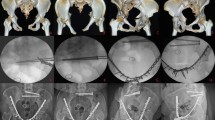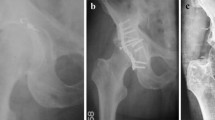Abstract
Purpose
To explore the diagnosis, treatment, and clinical prognosis of patients with both unstable pelvic fractures and concomitant acetabular fractures.
Material and methods
We retrospectively analyzed 21 cases of unstable pelvic fractures with concomitant acetabular fractures treated between January 2013 and December 2014. All 21 patients (18 males, 3 females), aged 43.5–55 years (range: 21–55 years), underwent surgery within four to 15 days (average = 6.5 days) after injury. We evaluated the pre-operative diagnoses, surgical approaches, types of fixation used, and prognoses.
Results
All 21 patients were followed-up for six to 18 months. The quality of post-operative pelvic fracture reduction (determined using the Matta scoring criteria) was excellent in five cases, good in 12, and fair in four. The clinical outcomes at the final follow-up (scored using the Majeed criteria) were excellent in ten cases, good in eight, and fair in three. The quality of post-operative acetabular fracture reduction (determined using the Matta scoring criteria) was excellent in five cases, good in 11, and poor in five. Hip joint function was evaluated at the final follow-up (using the D’Aubigné scoring system) and was excellent in eight cases, good in nine, and fair in four. The healing time was 12–18 weeks for pelvic fractures and 12–22 weeks for acetabular fractures. Post-operative wound infections in two patients were controlled after second operations featuring debridement and irrigation. We found no instance of heterotopic ossification, ischemic necrosis of the femoral head, or iatrogenic vascular or nerve injury.
Conclusions
Good therapeutic outcomes in patients with unstable pelvic fractures and concomitant acetabular fractures can be achieved via accurate diagnosis, careful pre-operative planning, a well-performed operation, effective reduction and surgical fixation, and appropriate exercise to allow functional rehabilitation.




Similar content being viewed by others
References
Karadimas EJ, Nicolson T, Kakagia DD et al (2011) Angiographic embolisation of pelvic ring injuries. Treatment algorithm and review of the literature. Int Orthop 35:1381–1390
Halawi MJ (2016) Pelvic ring injuries: emergency assessment and management. J Clin Orthop Trauma 6:252–258
Poenaru DV, Popescu M, Anglitoiu B et al (2015) Emergency pelvic stabilization in patients with pelvic posttraumatic instability. Int Orthop 39:961–965
Tile M (1988) Pelvic ring fractures: should they be fixed? J Bone Joint Surge(Br) 70:1–12
Letournel E (1980) Acetabulum fracture: classification and management. Clin Orthop 151:81–106
Matta JM, Tornetta P (1996) Internal fixation of unstable pelvic ring injuries. Clin Orthop Relat Res 329:129–140
Matta JM (1996) Fractures of the acetabulum: accuracy of reduction and clinical results in patients managed operatively within three weeks after the injury. J Bone Joint Surg(Am) 78(11):1632–1645
Majeed SA (1989) Grading the outcome of pelvic fractures. J Bone Joint Surg (Br) 71:304–306
Gansslen A, Pohlemann T, Paul C et al (1996) Epidemiology of pelvic ring injuries. Injury 27(Suppl 1):SA13–SA20
Vaidya R, Oliphant BW, Hudson I et al (2013) Sequential reduction and fixation for windswept pelvic ring injuries (LC3) corrects the deformity until healed. Int Orthop 37:1555–1560
Vallier HA, Cureton BA, Ekstein C et al (2011) Early definitive stabilization of unstable pelvis and acetabulum fractures reduces morbidity. J Trauma 69:677–684
Takashi S, Wade RS, David JH et al (2010) Combined injuries of the pelvis and acetabulum: nature of a devastating dyad. J Orthop Trauma 24:303–308
Zhu S, Wang M, Wu X et al (2005) Operative treatment of compound acetabular fractures through single ilioinguinal approach. Chin J Orthop Trauma 7:1025–1027
Matta JM (1994) Operative treatment of acetabular fractures through the ilioinguinal approach. A 10 -year perspective. Clin Orthop Relat Res 305:10–19
Acknowledgements
This work was supported by the National Natural Science Foundation of China (grant no. 81472146) and the Natural Science Foundation of WenZhou City (grant no. Y20160135). The funders played no role in the study design, data collection or analysis, decision to publish, or preparation of the manuscript.
Author information
Authors and Affiliations
Corresponding author
Ethics declarations
Conflict of interest
None.
Ethics statement
All procedures involving human participants were performed in accordance with the ethical standards of our institutional and national research committees, and with those of the 1964 Helsinki declaration and later amendments thereof, or comparable ethical standards. Formal Ethics Board consent was not required for this study.
Rights and permissions
About this article
Cite this article
Cai, L., Lou, Y., Guo, X. et al. Surgical treatment of unstable pelvic fractures with concomitant acetabular fractures. International Orthopaedics (SICOT) 41, 1803–1811 (2017). https://doi.org/10.1007/s00264-017-3532-0
Received:
Accepted:
Published:
Issue Date:
DOI: https://doi.org/10.1007/s00264-017-3532-0




